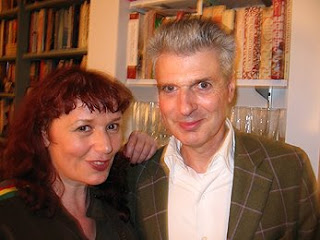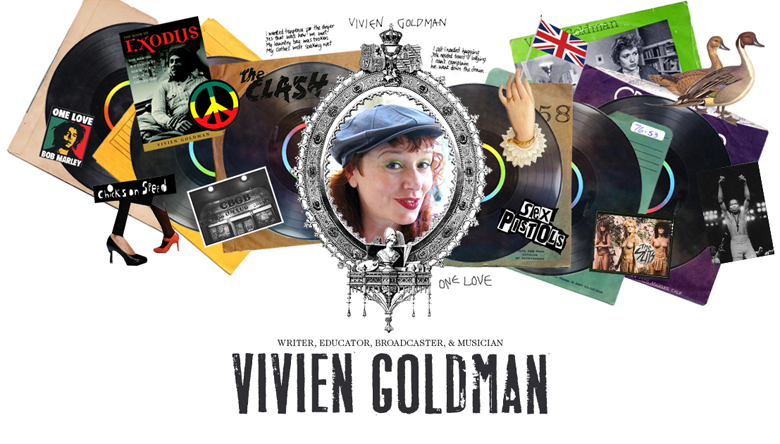In your recent post you mention hippie and punk as two sides of the same coin, (and I agree) yet so many self-identified punks profess to hate the '60's. Why? It seems this contradiction occurred back in '76 or so when various Pistols and certain others (Malcolm MacLaren perhaps) would be quoted as saying they "hate hippies and their bell-bottom jeans and long hair". It was clear they were simply referring to 60's fashion. But very soon it became "we hate hippies and everything they stand for like peace and love". Many people who read these comments about hating hippies took them very literally, and these people - especially would-be, 2nd generation punks - began to despise everything associated with hippie/'60's values, not just musical but philosophically and politically as well. I'm certain this contributed in some way to the rise of Thatcher and Reagan, especially in the UK where punk had far more cultural influence.
Regards,
Sean Oliver
Madison WI
Thanks for an astute question, Sean. I agree with you about how changing cultural values and the rejection of the hippie's peace and love vibration helped usher in what proved to be a depressing era for many, and a boom time for a privileged few. Why did it happen? There's a certain clockwork inevitability about each generation reacting to their parents - a formula that Savage's teen tome also illuminates - even when their fundamental beliefs are not that different at all. The old myths decreed that The King Must Die; the old order must crumble or apparently the world won't turn. I finally caught up with Clatterford, and was amused to hear the Women's Institute chairperson moaning that their meeting had descended into "Anarchy." Would that word have come to her gently reared rural mind without Johnny Rotten's yowl? As Savage said, first wave punk veterans are slightly surprised at punk's staying power, but perhaps it's because punk is about constantly questioning and overthrowing repressive systems which, sadly, never seem to go out of style. Given that classic reaction is how the world works, what's next for today's celebrity hungry scene?
PUNK PROFESSOR WEEK THREE
Time for our third session, punk people, and we're going to be looking at the aesthetics of punk, a recurring theme, particularly as in punk, visuals, style and aesthetics, are so clearly connected to the music.
Congratulations, you in the back there, for digging up some actual Vivienne Westwood type bondage trousers - unusual safety-pin - oh, I see, that's actually the dry cleaning tag and you accidentally put 'em on back to front… well, never mind, nice try. Apparently, part of being a Professor is the fun of seeing people you encouraged when they were starting out go on to do amazing work in the world, so it's particularly good to report that Jon Savage's new and long-awaited book, 'Teenage: The Creation of Youth Culture' (Viking) is as engrossing and stimulating as fans of his much-loved punk book, 'England's Dreaming', had hoped. Jon's one of the writers I picked and edited at Sounds whose arrival I remember particularly clearly - he had just graduated from Cambridge when he turned up in the office with a copy of his fanzine. The stapled pages evidenced a strong vision and he became one of our main writers. Seemingly self-possessed even then, Savage often wore a dark, baggy overcoat, drainpipe trousers and winklepicker shoes, his hair in a glossy black Teddy Boy quiff. His scathing wit is still intact in Teenage.
Regards,
Sean Oliver
Madison WI
Thanks for an astute question, Sean. I agree with you about how changing cultural values and the rejection of the hippie's peace and love vibration helped usher in what proved to be a depressing era for many, and a boom time for a privileged few. Why did it happen? There's a certain clockwork inevitability about each generation reacting to their parents - a formula that Savage's teen tome also illuminates - even when their fundamental beliefs are not that different at all. The old myths decreed that The King Must Die; the old order must crumble or apparently the world won't turn. I finally caught up with Clatterford, and was amused to hear the Women's Institute chairperson moaning that their meeting had descended into "Anarchy." Would that word have come to her gently reared rural mind without Johnny Rotten's yowl? As Savage said, first wave punk veterans are slightly surprised at punk's staying power, but perhaps it's because punk is about constantly questioning and overthrowing repressive systems which, sadly, never seem to go out of style. Given that classic reaction is how the world works, what's next for today's celebrity hungry scene?
PUNK PROFESSOR WEEK THREE
Time for our third session, punk people, and we're going to be looking at the aesthetics of punk, a recurring theme, particularly as in punk, visuals, style and aesthetics, are so clearly connected to the music.
Congratulations, you in the back there, for digging up some actual Vivienne Westwood type bondage trousers - unusual safety-pin - oh, I see, that's actually the dry cleaning tag and you accidentally put 'em on back to front… well, never mind, nice try. Apparently, part of being a Professor is the fun of seeing people you encouraged when they were starting out go on to do amazing work in the world, so it's particularly good to report that Jon Savage's new and long-awaited book, 'Teenage: The Creation of Youth Culture' (Viking) is as engrossing and stimulating as fans of his much-loved punk book, 'England's Dreaming', had hoped. Jon's one of the writers I picked and edited at Sounds whose arrival I remember particularly clearly - he had just graduated from Cambridge when he turned up in the office with a copy of his fanzine. The stapled pages evidenced a strong vision and he became one of our main writers. Seemingly self-possessed even then, Savage often wore a dark, baggy overcoat, drainpipe trousers and winklepicker shoes, his hair in a glossy black Teddy Boy quiff. His scathing wit is still intact in Teenage.

(Viking)
Jon once remarked to me "It was particularly gratifying that the definitive punk history was written by a posh homo," and I quite understood; the downside of mid-70s (and later) punk was an unreconstructed laddism sometimes expressed with an unthinking, knee-jerk homophobia or racism, that was at variance with the progressive, socially committed attitudes of, say, the Ruts and the Clash. Of course, parallel disputes still continue today, as Rock Against Racism and related organizations have had to rise again to combat problems in Europe. Now residing in rural grace in Wales, Savage can soothe his breast by walking to the sea, which is what he was about to do when he recalled what drove him to spend years writing the book. "It was a Runaways gig in 1976," he said, "I'd been in Chester, so it was the first time I'd seen loads of punks together at one time. They'd taken all these postwar youth styles and put them together with safety pins - brothel creeper shoes with 1960s trousers and zoot suits with winklepickers." The realization that fashion and style are an organic continuum that regenerates spontaneously for each generation's definition of youth set Jon thinking, with riveting results.

Vivien with Jon Savage
An exhibit of Jon's photos from the period is currently up in London's Institute of Contemporary Arts, named after his fanzine, Secret Public, and Jon sounds like he's flashing back in time as he describes the memories sparked by seeing his old pictures again. Now awash with chic boutiques and restaurants, in those days the grim, grey streets of Ladbroke Grove, home to the Clash and so many more, still bore war scars, three decades after the Armistice. "You see corrugated iron everywhere, going through all these (bleak) cityscapes and right at the end there's a Clash graffiti," said John. "And there was nothing else there. There really was nothing else there, when you think about it. That's why I liked it so much. Of course, it's all lasted much longer than one could ever have thought. Now punk is huge. In England, Punk has become the Year Zero. No-one remembers the 1960s any more." Some of Jon's strongest fanzine work was done in collaboration with a Mancunian artist named Linder, a close associate of the Buzzcocks, whose powerful collages deconstructing domesticity were direct descendants of political artists like 1930s collage master, the prominent anti-Fascist John Heartfield. His unforgettable satires of the power structure in Hitler's Germany also rang the alarm for punks battling neo-Nazi groups in Britain with Rock Against Racism. Collage is closely identified with punk - something about its scrappy, recycling technique just fits with punk's indie, sustainable ethos. The wild women of Berlin's Chicks on Speed collective always blend art and style with their avant-garde dance music. The band's Alex and Melissa collaborated on the startling cover collage of their "Girl Monster" compilation of girly music with artists including Bjork, the Slits, and your humble correspondent.

Under the Westway, Ladbroke Grove, 1977. Image courtesy of Jon Savage

Image courtesy of Chicks on Speed
Another worthy successor to the great Heartfield, Swedish artist Moki Cherry's rage against the destruction of the planet and the hypocrisy bedeviling our relationships, is pure punk. Perhaps it's no surprise that her musician daughter, Neneh, a sometime Slit herself, grew up to bridge punk, hip-hop and the free jazz she absorbed from her late father, trumpeter Don Cherry. Moki is a matriarch (her son Eagle Eye is also a musician,) and while she has made her whole life into a work of art and never stopped producing, her own great creative adventures have had too little recognition from the establishment. Few artists enjoy such a flexible range of creativity, each project stamped with a clear personality. Always excellent, Moki's contribution has ranged from making a children's theatre, including costumes and sets, to ceramics. She uses power tools to build emotive light boxes, and embroiders vivid satin hangings like those adorning some of Don's classics. But now it's Moki's limelight time, and she's engaged with collage. 'Moki, Sanna, Tonia,' a documentary about Moki and her longstanding artist friends, Susanne Beckman and Toni Roos, has prompted great press in Sweden. Even long-standing fans - face it, like me - were stunned at the punch of these peculiarly personal and political works -- and they're all good-looking, too. Please check Art-O-Mat site for dates and times of Moki Cherry's exhibition, SLEIGHT OF HAND.

"Fishwife" by Moki Cherry

"Future is Now" by Moki Cherry

"We're Open Minded" by Moki Cherry
NEXT WEEK'S ASSIGNMENT -
If each generation traditionally rejects their parents ways, will the next crew coming up say that celebrity obsession is boring and passé?
If each generation traditionally rejects their parents ways, will the next crew coming up say that celebrity obsession is boring and passé?
